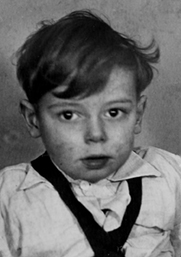Search for Names, Places and Biographies
Already layed Stumbling Stones
Suche
Klaus-Dieter Braasch * 1939
Valentinskamp zwischen Emporiohaus und Schanzenbäcker (früher Nr. 62) (Hamburg-Mitte, Neustadt)
HIER WOHNTE
KLAUS-DIETER
BRAASCH
JG. 1939
EINGEWIESEN 1942
ALSTERDORFER ANSTALTEN
1943 "VERLEGT"
HEIL- UND PFLEGEANSTALT
KALMENHOF
ERMORDET 11.11.1943
Klaus-Dieter Braasch, b. 10.10.1939 in Hamburg, committed to the then Alsterdorf Institute on 12.9.1942, transferred on 8.7.1943 to the Kalmenhof Sanatorium and Nursing Home in Idstein, murdered on 11.11.1943
Valentinskamp 70 (Valentinskamp 62)
Klaus-Dieter Braasch was born in Hamburg-Barmbek in the Finkenau lying-in clinic. His mother, Irmgard Braasch, née Hensler (b. 2.6.1912), had been diabetic during her pregnancy and had already suffered several miscarriages. Klaus-Dieter’s father, Kurt Braasch (b. 5.17.1899), was a dentist and came from Odsum on the Isle of Föhr. There were in the family two somewhat older brothers, Uwe and Peter.
As a toddler, Klaus-Dieter came down with measles; seven months later his parents noticed that their son was developing differently than his brothers. In November 1941, in the Anschar Diocesan Educational and Nursing home at Tarpenbeckstrasse 107, Klaus-Dieter contracted enteritis and a bad case of malnutrition.
He was described as an exceedingly delicate, pale, and serious child. In a psychiatric evaluation of 5 October 1942, done by the State Youth Office of Hamburg, which dealt with whether or not home schooling was appropriate for him, it was affirmed that he could get around on his "bowed legs” without help. He did not yet speak and "loves to lick everything. He scarcely knows what to do with toys. He favors crude cylindrical logs and building blocks.” The examining assistant Dr. Zahn found fault with the lack of perseverance and thought it "impossible” to take him to a home for children because Klaus-Dieter was very restless, allegedly screamed often, and could not be left alone. In conclusion, Zahn judged: "The boy cannot remain with the mother and it is only a question of safeguarding him.” Apparently, Klaus-Dieter’s parents’ marriage had not survived; at this point in time they were living separately.
With the finding that Klaus-Dieter was a danger to his healthy siblings and a diagnosis of "abnormal motility of emotions” (pathological excitability), the three-year old boy was sent, at the expense of the Social Welfare Administration, to the then Alsterdorf Institute on 9 December 1942.
Klaus-Dieter’s way to death began eight months later, on 7 August 1943, when, after a series of heavy air raids over Hamburg, he was "chosen” for a transport to the Kalmenhof Sanatorium and Nursing Home at Idstein im Taunus. The official grounds for the transfer to Kalmenhof was given as serious damage to the Alsterdorf Institute.
Even after the official halt to the first phase of the "euthanasia program” in August 1941, handicapped children, teenagers, and young adults were killed in the Kalmenhof "Children’s Special Ward" by means of medical overdoses.
The selections were carried out on the regular rounds of the institute’s director, Wilhelm Grossmann and Dr. Mathilde Weber. Klaus-Dieter Braasch was among the 20 children, who upon arrival were placed in another ward. When a few of the children developed diarrhea in October, they were placed in the "Children’s Special Ward,” where they awaited their deaths. Klaus-Dieter Braasch and Manfred Bala (see his biographical sketch), who also came from the Alsterdorf Institute, died two months after their arrival on 11 November 1943, shortly after Klaus-Dieter’s fourth birthday.
Translator: Richard Levy
Kindly supported by the Hermann Reemtsma Stiftung, Hamburg.
Stand: May 2020
© Susanne Rosendahl
Quellen: Archiv Evangelische Stiftung Alsterdorf, Patientenakten der Alsterdorfer Anstalten, V 47 Klaus-Dieter Braasch; Wunder: Exodus, S. 189–195.


